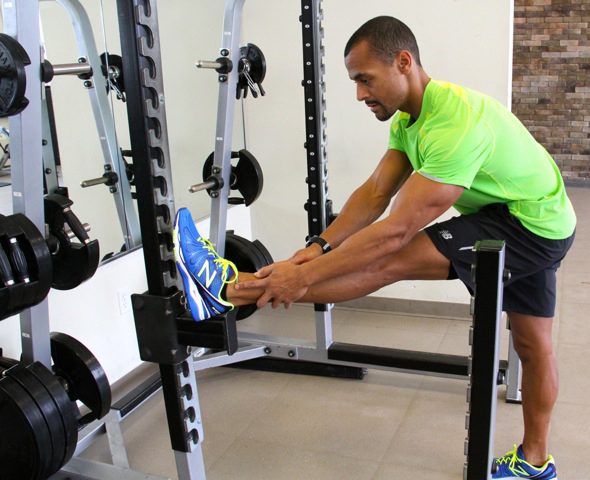How to Avoid Running Injuries
If you’re a runner, you’ve probably experienced some pain and discomfort throughout your training. Many runners may not realize that

If you’re a runner, you’ve probably experienced some pain and discomfort throughout your training. Many runners may not realize that common ailments such as patellar femoral syndrome or IT Band syndrome can be avoidable or at least addressed early for successful treatment. What you choose to do before and after your runs can impact your performance and the achievement of your fitness goals. Implementing some key ‘prehab’ strategies into your weekly routine can go a long way when it comes to injury prevention. Here are some simple tips to keep you healthy and performing at your best.
Lunge before you run
Warm up is key ‘ it’s as simple as that. It’s critical to increase the circulation to your muscles and joints in preparation for running. Doing so will create more fluidity with movement and increase muscle pliability around, enabling them to perform and support your joints with greater efficiency. The walking lunge is a great warm up exercise as it activates all the major muscles in your lower body, while also assisting in stretching out your hip flexors. Be sure to lunge through deep full range of motion for maximum benefit.
Progression is key
Most spring running injuries stem from doing too much too soon. Remember, if you are a runner who avoids the outdoors in the winter, you’re joints are not going to be accustomed to the impact when you hit the pavement. Even though your cardiovascular system may be conditioned from some indoor winter cardio training, progression is important when it comes to returning to the pavement. Regardless of season, you’ll want to try to not overdo it when it comes to adding mileage to your weekly running routine. Doing too much too soon is often what gets new and seasoned runners into the injury zone. A good rule of thumb is to increase about 10% distance per week when training for a distance race.
Improve muscular balance
Most of the common repetitive strains and injuries I witness with clients who are competitive or recreational runners are ailments that stem from muscular imbalances. Many injuries are avoidable if the body is able to withstand the prolonged impact of running. Running mechanics are based on natural gait that we were born with, however; other lifestyle implications such as sitting for long hours can wreak havoc on our posture, shorten our muscles in the front of our body and cause our posterior chain (muscles in the back of the body) to be comparatively inactive. The result is muscular imbalance and postural weakness. Compound that with the repetitive impact of running and you predispose your unstable joints to uneven strain. The key to improving muscular imbalances is to firstly seek out a fitness professional to undergo a functional movement screen. This allows you to identify areas of weakness, imbalance, dysfunction and poor mobility.
Functional strength training
Include 2-3 days per week of functional strength training. This entails, using the knowledge from your functional movement screen to address areas of weakness during your strength conditioning workouts. Functional strength training involves incorporating whole body natural movements through full range of motion. Exercises such as deep lunges, core integration, deadlifts and squats can help improve joint strength and therefore transfer to enhanced running mechanics. Check out this Runner’s Workout for some great tips and exercises to improve your running and decrease injury risk.
Myofascial release
Tools such as foam rollers and massage balls can be instrumental post-run to ensure that you restore muscle pliability, enhance post-run recovery and help increase tissue tolerance over time. Try rolling out your quadriceps and IT bands regularly after you run to help remove adhesions and tension that can develop with repetitive impact exercise. Trigger Point and The Treadmill Factory provide several effective and very portable tools designed to help release tight overused muscles. For some tips on how to use a foam roller and lacrosse ball to release tight muscles, check out this quick video on Myofascial Release Techniques.
Control inflammation and enhance recovery
Swelling, inflammation, pain and infection are all common injuries to the active population. Products that increase microcirculation can be helpful to speed up recovery. Lymphdiaral from Pascoe Canada is a homeopathic treatment to be used preventatively or for treatment to increase microcirculation and noticeably speed up your recovery. So you can get back to the activities you love.
We all here how great Omega 3’s are for heart health, cellular health and a long list of other benefits; however taking them regularly can also help enhance your recovery. The EPA component of Omega 3’s have an anti-inflammatory effect known to help reduce inflammation post workout, essentially allowing you to train harder, sooner. NutraSea HP from Ascenta is an ideal formulation for the active person, with a 3:1 ration of EPA to DHA.
Whether you are a recreational athlete or someone wanting to perform at your absolute best, use these tips to optimize your performance and reduce the risk of injury so that you can keep doing what you love.
Brent Bishop is a celebrity trainer, on-air fitness expert, author and owner of Think Fitness Studios.




